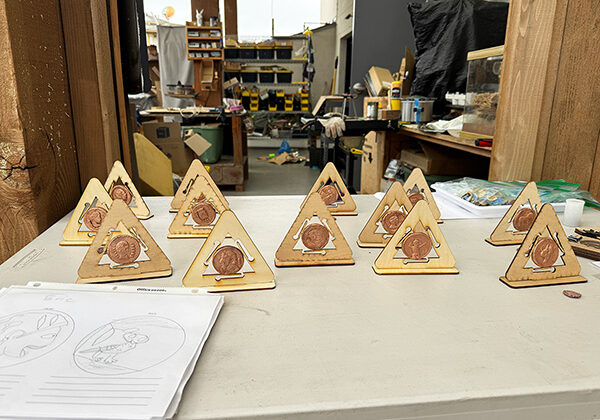Specialty Classes
UNLEASHING CREATIVITY
At Gillispie, specialty classes are not just enrichment—they are essential to a well-rounded elementary education. Integrated into the daily experience, our specialty programs spark creativity, collaboration, and self-expression while supporting core academic learning. For families seeking a La Jolla elementary school that nurtures the whole child, Gillispie offers a dynamic and student-centered approach.
What sets our specialty classes apart?
Cross-Disciplinary Learning
Specialty classes are woven into academic subjects, creating hands-on projects that promote teamwork, innovation, and critical thinking.
Multi-Grade Collaboration
Students engage across grade levels, building a strong sense of community and learning from one another’s ideas and perspectives.
Student-Driven Exploration
Our teachers listen closely to student interests, guiding them in creating meaningful, curiosity-driven learning experiences.
Dedicated Creative Spaces
Our unique learning environments include The Sandbox—an innovation hub with a maker space, auditorium, theatre, music room, library, and teaching kitchen. Students also enjoy an art bungalow and garden for elementary grades, and a dedicated art atelier for preschool and pre-kindergarten.
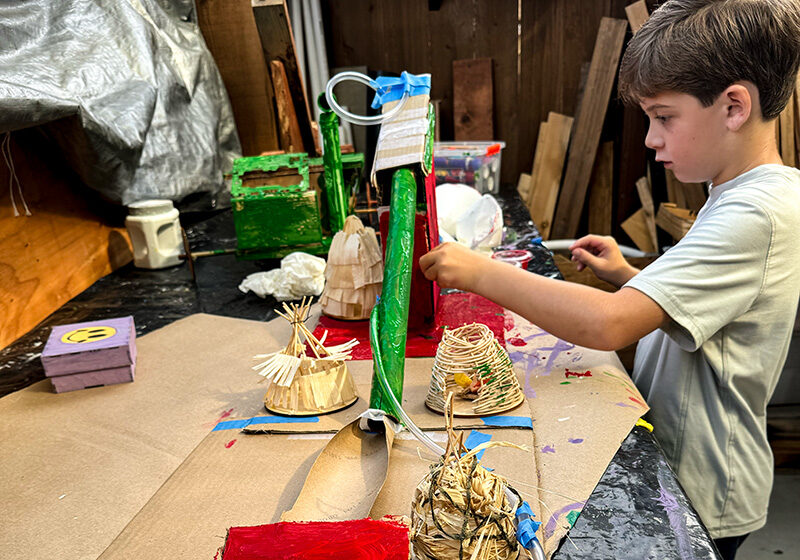
BEYOND THE BASICS
Through the lenses of art, science & design, music, digital literacy, library, Spanish, and P.E. students explore their academic subjects for creative, vibrant, and meaningful learning.
Imagine...
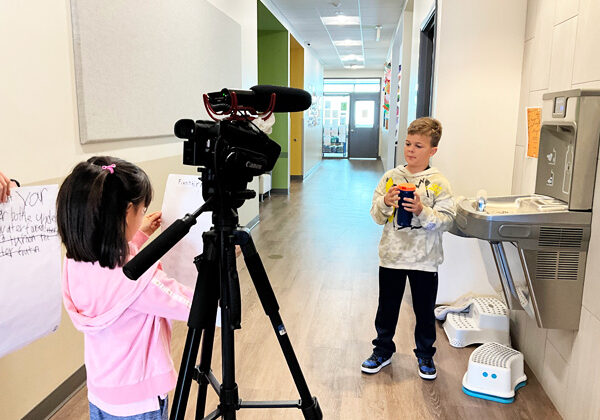
Grade 1 students becoming authors, collaborators, and media producers.
In this cross-disciplinary project, students learned the foundations of explanatory writing in class—using transition words, topic sentences, and clear steps to write instructional booklets. Working in teams, they co-authored their guides, transforming them into scripts for their own “How-To” videos. Each group made decisions together: who would speak, demonstrate, or film. This project blended writing, collaboration, and digital literacy, encouraging students to think critically, communicate clearly, and work as a team. Gillispie’s integrated approach to learning enables young students engage deeply, creatively, and with purpose.
Grade 2 students rolling pumpkins down ramps to test the stoppers they designed to prevent the destruction of a paper towel village.
Inspired by the story Runaway Pumpkin, Gillispie’s cross-disciplinary project combined literature, science, engineering, and visual art. Students used Gillispie’s Design Thinking Model to brainstorm, build, test, and redesign “pumpkin stoppers,” learning to work within real-world constraints. The project also included seeing Yayoi Kusama's "Dreaming Pumpkin" at Museum of Contemporary Art San Diego in La Jolla and creating their own polka-dot pumpkins for the project in Art. Read our story, "Rolling with Pumpkin Attitude" in the Gillispie Gem.
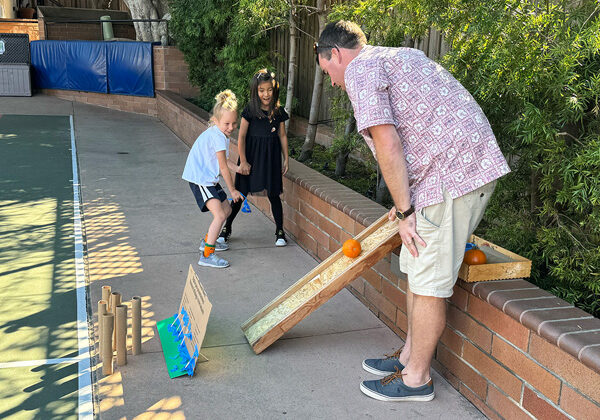
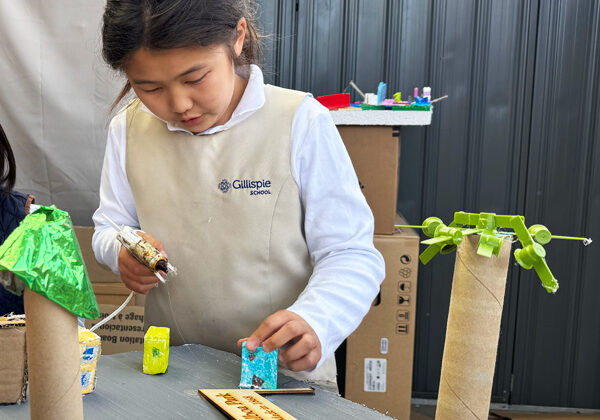
Grade 3 students deepening their understanding of San Diego history and geography through hands-on creations of its landmarks.
Students worked in small groups to design and build scale models of iconic local sites. Through their design work, students learned about measurement, materials, and collaborative decision-making—skills rooted in math, science, and communication. Connecting academic content with creative, hands-on work engaged students and results in deeper learning.
Grade 4 students solving a real-world problem—how can we help animals safely cross busy roads in California?
Sparked by their natural curiosity and a love of animals, our students explored the conflict between wildlife and human development through The Animal Crossing Project, an interdisciplinary challenge that blends literature, geography, ecology, and design. Inspired by the novel A Wolf Called Wander, students asked big questions about habitat fragmentation and its effects on animals and people. Working in teams based on California’s regions, they researched local species, designed creative wildlife crossings, and built detailed scale models complete with laser-cut animals and regional backdrops. This project brought science and storytelling together in a powerful learning experience. Read our article "Bridging the Wild".
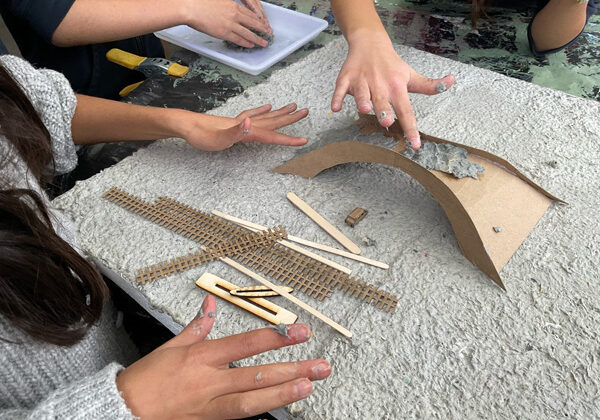
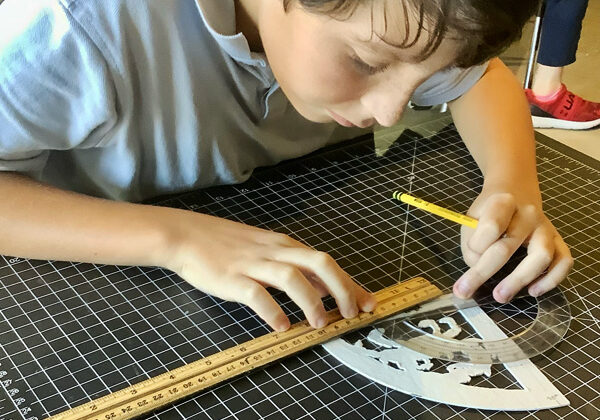
Grade 5 students designing and building a tool once essential to sailors navigating the seas.
Beginning with an inspiring study of early European maritime exploration in the classroom, this project allowed fifth graders to research, design, make, and use a functioning astrolabe—an ancient device used for measuring the height of the sun and stars above the horizon. Through laser-cut designs, artistic details, and careful assembly, students blended history, art, and math. Field testing brought their creations to life, as geometry lessons on triangles and the Pythagorean Theorem connected directly to real-world applications, echoing the ingenuity of explorers from centuries past.
Grade 6 students integrating art, design, and history to deepen their understanding of Ancient Greece and Rome.
Powerful, hands-on learning unfolded as sixth graders studying ancient civilizations designed and created their own copper coins. Students explored historical symbolism, sketched and laser-cut stamp designs, crafted prototypes, and torch-fired copper clay to produce authentic, weighty coins. This interdisciplinary project fused history, art, and design—leaving students with a deeper connection to the past and a lasting reminder of their creativity and craftsmanship. Read our story "Designing Deeper Learning".
ABOUT OUR SPECIALTY CLASSES
Follow our links to find out more about each of our specialty classes.
Students in Kindergarten through Grade 6 take art class in our dedicated art bungalow and garden. Surrounded by flowers, birds, and fruit trees, students draw inspiration from nature. Emphasizing innovation and creativity, our art program encourages students to explore various mediums and develop their unique artistic voices. Art classes are hands-on, allowing students to experiment and learn through doing.
Early childhood students engage in wide-ranging artistic activities throughout their day in their classrooms and in the Art Atelier.
Open Art is a popular option for students to spend some time crafting their own pieces. Open Art is available during snack and recesses.
Reading is the core of both academic and personal competencies. Students from preschool to Grade 6 have weekly library classes to develop students’ love of literature and foster their social-emotional development.
Early childhood (EC) students have regular storytime visits where they sing and sign together. EC library lessons focus on stories with a musical connection, a social-emotional component, a hands-on activity, or a connection to a relevant theme. Our librarian makes library time a wonderful and fun experience.
Elementary students learn how to browse and check out books and are encouraged to give their input on books and topics they would like to see added to our collection. Lower elementary students focus on book care and navigating the library space. Upper elementary classes hear and discuss a novel each time they visit the library, in addition to their independent reading and browsing time. Students also have the opportunity to meet professional authors who share their writing process and experiences, and collaborate with them to refine their writing through workshops.
Open Library is a popular option for students to spend some time enjoying a book or just quickly pop in to return one book and check out another. Open Library times are before and after school and during snack and recesses.
If you’d like to explore our collection, check out our online library catalog here.
Our students belong to Generation Alpha – the generation born into a fully internet-connected world. They are purportedly the most tech-savvy generation and are often referred to as “Generation AI” because artificial intelligence has been part of their world since they were born.
We are excited to be part of this extraordinary time with our students, making it a point to be aware of technological advancements and how they may impact a child’s learning journey. Our digital literacy curriculum is rooted in Gillispie ICARE Values, fostering safe and responsible technology use.
Our one-to-one digital literacy program leverages the creative power of iPads for in-class learning. Building on the ISTE Standards for Students, K-6 learners use a variety of native as well as third-party apps to explore ideas, solve problems, and share their work. In practical terms, that means your child will:
- Choose the right tool for the task. Each project begins with a simple question—“What am I trying to do?”—followed by a guided discussion about whether technology will help and, if so, which app (camera, drawing, presentation, etc.) makes the most sense.
- Build essential skills. Age-appropriate lessons weave in keyboarding, safe internet practices, creative drawing, word processing, multimedia presentations, and introductory coding.
- Create and collaborate. Students work individually and in teams to design digital posters, record reflections, produce mini-videos, and even create podcasts—learning to give and receive feedback along the way.
- Share responsibly. Finished work is celebrated in class and, when appropriate, shared with parents or the wider school community, reinforcing good digital citizenship and clear communication.
Our goal is simple: empower every child to turn bright ideas into real-world creations while developing the confidence, curiosity, and decision-making skills they’ll need in our increasingly digital world.
All students, Preschool through Grade 6, take music classes. Our music program provides the opportunity for every student to explore the world of music through singing, playing instruments, composing, listening, and moving to music. Activities are designed to help each child develop musical skills, as well as know and appreciate many different types of music.
From their first music class, students cultivate a variety of diverse musicianship skills. The two most notable in the early years are steady beat and matching pitch. Beginning with Solfege singing and percussion, students establish a strong foundation for collaborative performance and composition. Our curriculum focuses on developing music reading skills and encompasses a diverse range of genres, from Beethoven to the Beatles to popular music.
Beginning in these early years readies our kindergarteners to begin reading simple music daily. This daily exposure to reading music leads to the huge success in our first to sixth-grade students in their instrumental presentations.
Music is also integrated in many cross-disciplinary projects. As an example, our 5th and 6th grade recently created their own albums. Over the course of the year, each student composed ten songs and designed their album cover in Art. They studied the relationship between music and visual art, learning how imagery can enhance musical expression.
Our Physical Education program goes beyond traditional sports instruction, incorporating a holistic approach to health and wellness. Students develop essential motor skills through age-appropriate movement and games including team sports like field hockey, kickball, lacrosse, basketball, and baseball. To cultivate a well-rounded understanding of the human body, students also explore anatomy, nutrition, and the importance of sleep. Additionally, mindfulness techniques are incorporated to build resilience and emotional intelligence.
Our program integrates cross-curricular learning opportunities. For example, students combine Spanish language practice with physical games, and explore Native American culture through hands-on activities like a water pouch relay race created in science and design classes.
Through these experiences, students develop a lifelong passion for physical activity and a strong foundation for overall well-being.
Elementary students in Grades K through 6 attend Science & Design in the Sandbox. This dedicated space consists of an airy, open-walled classroom with an adjacent Maker Deck.
Science is taught through hands-on experiences that emphasize the process of discovery and productive habits of mind. The science curriculum remains flexible, investigating topics from Earth, Life, and Physical Sciences while ready to take a deeper dive when student readiness and curiosity suggest. Maker projects are often used to render science concepts concrete, as students make cars to investigate Newton’s Laws of Motion, carefully construct functioning electric motors from scratch as they study basic circuitry, or learn about light and anatomy through the fabrication of a functioning eye model.
Design aims to extend and deepen topics of interest through cross-disciplinary projects that involve making skills and the Design Thinking model. The seed of a given project may come from a classroom social studies unit, playground need, shared ecological or humanitarian concern from the greater community, cultural event, literature study, or even an overheard conversation that leads down a fruitful path. Once conceived of and planned by the classroom and specialty teachers involved, our Science-Design teachers coordinate the project through its final showcase, which, whatever its form, aims to share the students’ learning and process.
Throughout the elementary years at Gillispie, Spanish is taught and reinforced with activities like singing, playing games, making flashcards, and practicing dialogue. Exposure to the art, music, food, and histories of notable Spanish-speaking countries around the world is also part of the curriculum.
In our Spanish language program, students not only grasp language structure and linguistics but also gain insight into the intricacies of culture. They learn that the way a language is spoken reflects the values of a people, enabling them to develop a deeper understanding of language, culture, and community.
Students in Grades 2 through 4 receive targeted instruction through the SMARTS Executive Functioning Curriculum, a research-based program designed to help students develop key executive functioning skills, including goal setting, flexible thinking, time and material organization, working memory, and self-monitoring.
At Gillispie, we believe so strongly in the power of these skills that we’ve dedicated extra time in the school day to help students develop them.
These skills are essential for fostering a growth mindset and encouraging students to take on challenges with confidence. Our students are not only preparing for success in school — they're building the foundation for success in life.
